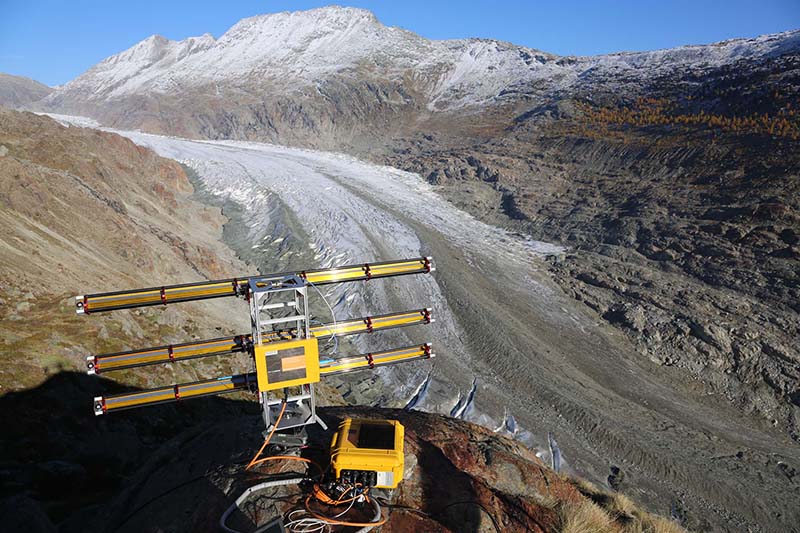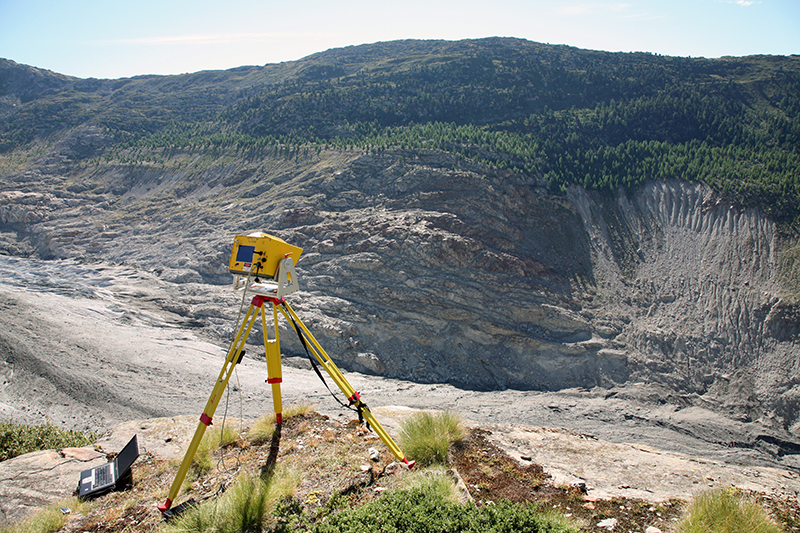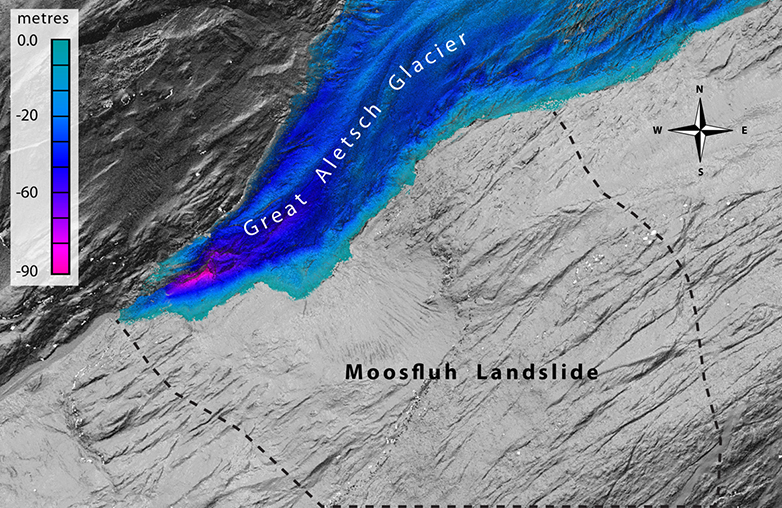Chronicle of a catastrophic landslide
Dramatic developments have been documented at the Aletsch glacier, where the ice has retreated at such a pace that an adjoining slope has also started to move rapidly. With the help of a unique dataset, researchers are able to demonstrate a direct connection between the ice loss of the Aletsch glacier and the slippage of the Moosfluh slope.

The fact that the Moosfluh cablecar was forced to stop operations temporarily last autumn, despite the moveable foundation at the mountain station to accommodate groundmovement, says much about the dramatic events that have occurred in the Aletsch region. The Moosfluh, the slope that borders the Aletsch glacier, has been moving for many years. The whole slope, of about a square kilometre, is moving downhill at an unprecedented pace. Geoscientists can now show that the instability of this slope is connected directly to the retreat of glacier ice and thus to climate change by drawing on a unique dataset. Researchers deployed various measuring instruments and systems to collect measurement data, including airborne and terrestrial laser scanners, radar and GPS measurements. They also analysed satellite and historical data (glacier height and length) and topographical maps.
“Based on our years of measurements, we were able to detect a critical threshold in the shrinkage of the glacier at which the situation rapidly deteriorated,” says Andrew Kos. The former ETH engineering geologist is lead author of a study that presents the findings of a long-standing and unique measurement campaign in the landslide region. It has just been published in the prestigious journal Geophysical Research Letters.
The threshold in question came in the mid-1990s. At this point, glacial ice began diminishing at a much faster rate than before. This, in turn, accelerated the slope movement – although with a time lag of about nine years. Using earlier measurement data, researchers were able to reconstruct how the glacier had shrunk, steadily yet moderately, up to the early 1990s. The Moosfluh also moved at an average rate of less than one centimetre per year, as analysis of historic photogrammetric images show. But things started going downhill after 1995: the Aletsch glacier lost its ice volume massively at the point where it meets the Moosfluh, which accelerated markedly with an average of 30 centimetres a year.
Movement begets movement
Researchers found another sign that the situation had accelerated dramatically – rockfalls at the foot of the slope were increasing in frequency and volume. Before 2005, geologists recorded only one single incident of rockfall, representing about 5,000 cubic metres of rock debris; by 2011, two rockfalls of similar dimensions had taken place. However, between 2011 and 2012, seven rockfalls thundered down the valley, and although only two occurred between 2012 and 2015, they were far more powerful, loosening 10 and 30 times more rock debris respectively than the 2011-2012 incidents. And finally, in 2016, 2.5 million cubic metres broke off in a single incident. “The foot of the slope is particularly critical for the stability of the entire slope,” says Kos.

If the ice releases the foot of the slope, it will lose its abutment and begin to pitch and slide. This movement begets further movement throughout the entire slope, right up to the flat mountain ridge that forms its upper extension – which is subsiding as a result. This, in turn, creates tension that opens up deep ruptures in the ground.
Faster than science previously knew
The fact that slopes are moving through glacier shrinkage in itself is nothing new for the geologists. However, they had always assumed that this was a slow, barely perceptible process. Even co-author Florian Amann was surprised by the pace they observed in the Aletsch region. “For geologists, the speed with which events on the Moosfluh have developed is extreme.”
The remarkable thing about the study is the combination of different measurement methods and the duration of monitoring. Physicist Tazio Strozzi first encountered the Moosfluh in 2008. At the time, he was analysing satellite-based radar images on behalf of the Federal Office of the Environment (FOEN), in order to identify potential natural hazards at an early stage. In the process, he was struck by how rapidly the Moosfluh had transformed. Kos, then senior assistant in the Engineering Geology group at ETH Zurich, promptly initiated a research project to investigate the causes and brought his colleague Amann on board.
Later, the study was conducted by ETH researchers from the Chair of Geotechnical Engineering, then led by the current ETH Rector Sarah Springman. It was supported by the FOEN, the co-authors and a number of private engineering practices.
No second chance
The authors take pride in the fact that they were able to document this process in such detail. As far as they know, no comparable example exists in literature that measures a direct connection between glacier shrinkage and the development of a rock slope over a long period. “You have to invest many years into building up a dataset like that. And you can’t just reconstruct such a case, because the incident under observation is unique. You have only one chance to carry out these measurements. We couldn’t run a repeat if something went wrong,” says Kos.

When they began to investigate this development, no one had yet addressed the instability of the Moosfluh scientifically. This changed suddenly with the massive transformation in rock instability in summer 2016.
It is unclear whether events will continue to develop at such a breathtaking pace in the future. The permanent monitoring is now the responsibility of the canton of Valais, says Kos. “We managed to gather the data we needed for our enquiries.”
Reference
Kos A, Amann F, Strozzi T, Delaloye R, von Ruette J, Springman SM. Contemporary glacier retreat triggers a rapid landslide response, Great Aletsch Glacier, Switzerland. Geophysical Research Letters 43, Accepted article online 7 Dec 2016; doi: external page10.1002/2016GL071708call_made
